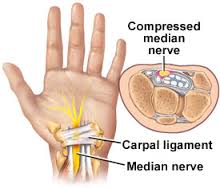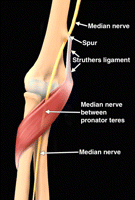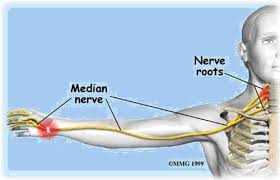Carpal tunnel syndrome is a common diagnosis and most people, medical and non-medical, think surgery is the only option for optimal recovery. Although surgery is sometimes the most appropriate intervention, it surely is not the only option. See, I have a hunch. If more people initially sought physical therapy treatment for CTS when their symptoms first began, the operating room might be a little less busy.
This past week, I decided to do some internet browsing to note the main consensus for treating carpal tunnel syndrome; physical therapy is barely mentioned as an option. After channeling my inner nerd to research some peer-reviewed, scientific literature to prove physical therapy is a good option for CTS, I was stunned; it doesn’t really exist. But, clinically, myself and other colleagues have had great success treating carpal tunnel syndrome–without anesthesia, mind you. So, why is there a disconnect between research and the clinic? Likely, because physical therapy is usually thought for CTS after surgery, not before.
The most common treatment suggestions for CTS (via internet search):
1st: Non-surgical treatments: splinting, cortisone shots and NSAID’s (non-steroidal anti-inflammatory drugs). (Funny that PT is not listed under non-surgical)
2nd: Alternative medicine: chiropractic, yoga and acupuncture.
3rd: Surgery
So what would a physical therapist do for CTS symptoms?
A complete musculoskeletal evaluation for a correct diagnosis
Manual therapy for soft tissue manipulation and joint mobility
Exercise prescription for stretching and strengthening
Posture education
Fine motor coordination
Functional task practice
Ice for swelling
Wrist splints at night
Let’s take a brief look at CTS
Carpal Tunnel Syndrome is pressure on the median nerve as it runs through the carpal tunnel (wrist). The top layer (ceiling) is the transverse carpal ligament (the structure cut during surgery), the bottom layer (floor) are the carpal bones, and in between a bunch of tendons run through the tunnel along with the median nerve.
Imagine a crowded elevator. You’re in the back, in the middle and more and more people keep getting on the elevator. You’re thinking: “If one more person gets on this elevator…” and soon you are squished in the back with your nose touching, thus smelling, the back of the man in front of you. You’ve instantly become a human sardine. That’s how the median nerve feels with CTS: compressed with no where to run.
Signs and Symptoms of CTS
Numbness, tingling, burning of the thumb, index and/or middle finger
Wrist pain at night
Weakness of grip
Thenar atrophy (thumb muscle wasting away)
Causes of CTS
Being Female: yep, we’re dainty. In general, women’s wrists are anatomically smaller
Swelling: from fluid retention, mostly likely during pregnancy
Carpal (wrist) bone out of place
Trauma to area
Ganglion or any other structure that might be taking up space in the tunnel
But, what if your CTS symptoms are not actually coming from the wrist?
Pronator Teres Syndrome is pressure on the median nerve as is passes between the ulnar and humeral heads of the pronator teres muscle.
Signs and Symptoms of Pronator Teres Syndrome
Tenderness and tightness of the pronator (forearm) muscles
Numbness, tingling, burning of the thumb, index and/or middle finger
Loss of strength: thumb and pronation
Causes of Pronator Teres Syndrome
Repetitive pressure on the inside of the forearm (i.e. holding a baby)
Hypertrophy (bulking up) of the pronator teres muscle from repetitive pronation
Other structural abnormalities: ligament of Struthers, tight bicipital fascia, bone spur
Or, then again, your symptoms could be coming from your cervical spine.
This is an important area to consider when patients present with CTS symptoms. The median nerve is supplied by nerves C5, C6, C7, C8 and T1. If there is any narrowing of the foramen (nerve tunnel out of the neck) from a disc herniation or degeneration, it may be the true diagnosis and source of symptoms. It is important to find a PT who will evaluate the entire median nerve pathway to ensure a correct diagnosis.
A patient story
Currently, I am treating someone with CTS symptoms. This is her story and my inspiration for this blog post.
This past winter, my patient was told by two surgeons that she had bilateral (both wrists) carpal tunnel syndrome and her only option was surgery. At that time, she had a 3-week old baby and so she asked if there was something more conservative to try before surgery. Both surgeons responded “no”. She did try chiropractic and acupressure treatments, but did not have any symptom relief. With surgery finally scheduled this summer, her sister recommended physical therapy to ensure she had explored all conservative options before her date with the operating room.
Her symptoms began in her 7th month of pregnancy and continued to worsen over time. She had the classic signs of CTS: burning that changed to numbness of the thumb, index and middle finger, night pain and weakness of her hands for all fine motor tasks (putting in earrings, writing, opening a water bottle). She had swelling in her wrists, but more importantly, her forearm muscles felt like ROCKS! They were so tight and painful. Her thumbs were weak, but she had good strength of her index and middle finger. Her cervical spine was evaluated, but was not a contributing factor.
Her PT diagnosis: Carpal Tunnel Syndrome AND Pronator Teres Syndrome
The craziest part of her story is that she was told by one surgeon that she should get carpal tunnel surgery on both wrists, but if the symptoms were coming from her forearm they wouldn’t know until they do the surgery. Well, that just seems silly. Why would you cut a structure in the wrist if it’s not the actually causing the problem?
We got to work immediately. She was educated to continue to wear her splints at night and add in her PT home exercise program. After two weeks of manual therapy, exercise progressions for stretching, strengthening, fine motor coordination and icing, she reported 50% improvement in her symptoms. Her best statement: “They’re starting to feel like hands again.”
We’re not out of the woods yet, but she has currently postponed her surgery because she can now put on earrings and open water bottles, tasks she has not been able to do for over 6 months.
If you have carpal tunnel syndrome or symptoms similar to those described above, try physical therapy. It just might work!
© 2014 and Beyond. ALL BLOG CONTENT at duncansportspt.com by Lori Duncan PT
ABOUT THE AUTHOR
 Lori Duncan, DPT, MTC, CPT is a respected Physical Therapist, Manual Therapist and Pilates instructor in Lafayette, CO. Lori is passionate about preventive physical therapy and education and is a nationally recognized presenter. She can be reached at [email protected]. You can also follow Duncan Sports Therapy + Wellness on Facebook [4] & Instagram [5] for more free tips and information.
Lori Duncan, DPT, MTC, CPT is a respected Physical Therapist, Manual Therapist and Pilates instructor in Lafayette, CO. Lori is passionate about preventive physical therapy and education and is a nationally recognized presenter. She can be reached at [email protected]. You can also follow Duncan Sports Therapy + Wellness on Facebook [4] & Instagram [5] for more free tips and information.


